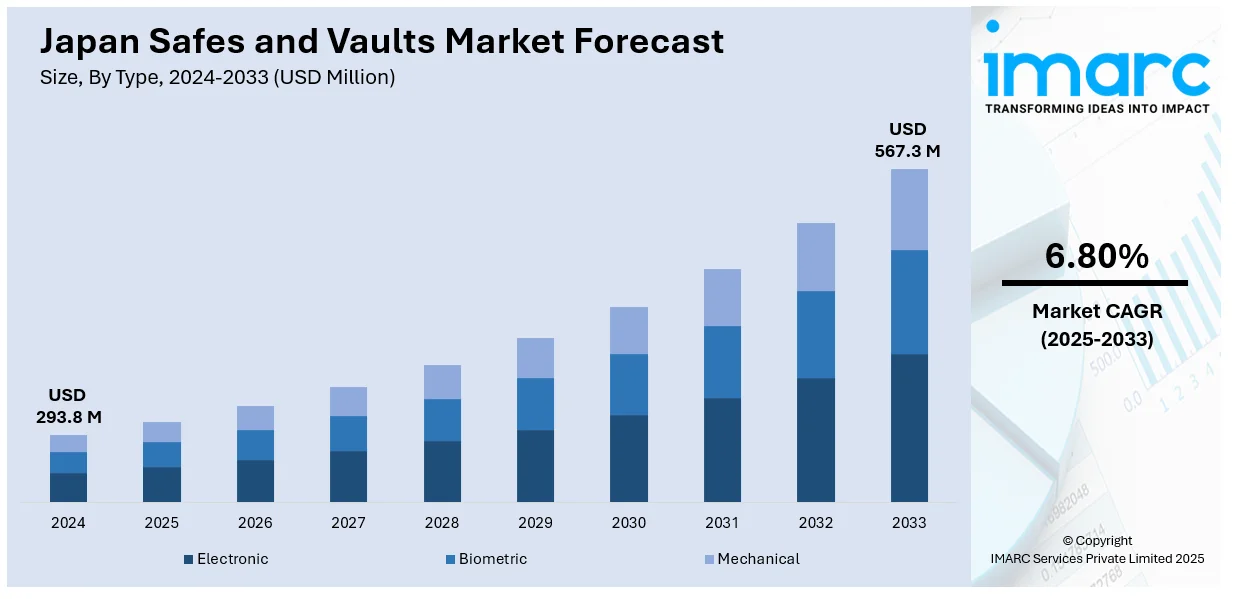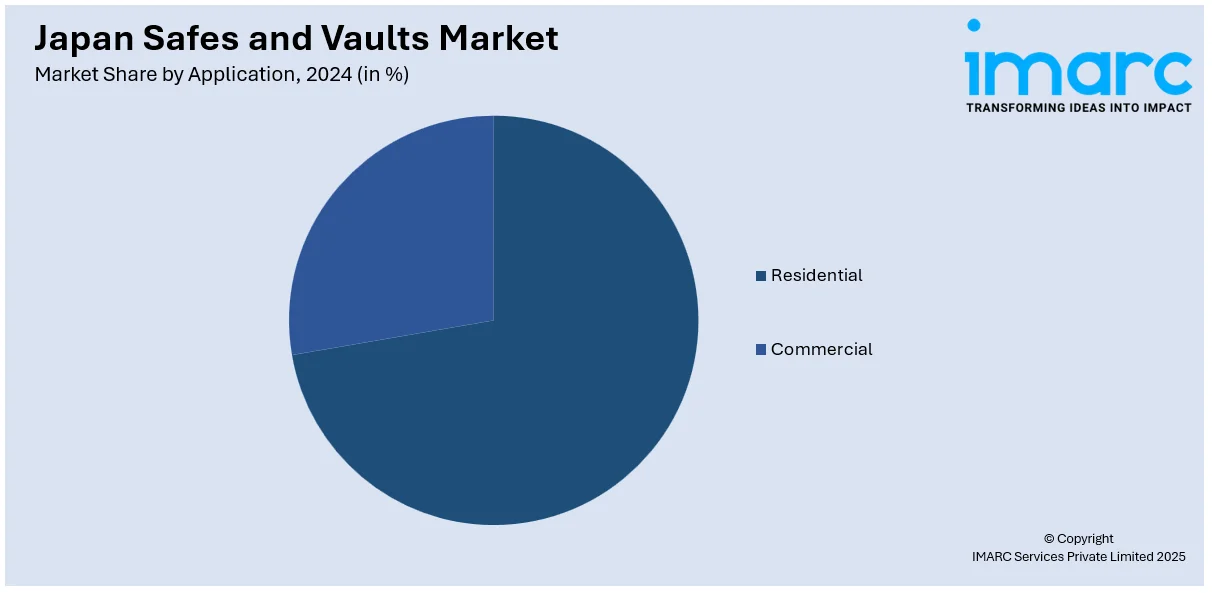
Japan Safes and Vaults Market Size, Share, Trends and Forecast by Type, Function Type, Application, End User, and Region, 2025-2033
Japan Safes and Vaults Market Overview:
The Japan safes and vaults market size reached USD 293.8 Million in 2024. Looking forward, IMARC Group expects the market to reach USD 567.3 Million by 2033, exhibiting a growth rate (CAGR) of 6.80% during 2025-2033. The market is expanding due to growing concerns about residential and commercial security, rising adoption across banking and financial sectors, and increasing demand for fireproof and tamper-resistant storage solutions to protect cash, documents, and valuable assets.
|
Report Attribute
|
Key Statistics
|
|---|---|
|
Base Year
|
2024 |
|
Forecast Years
|
2025-2033
|
|
Historical Years
|
2019-2024
|
| Market Size in 2024 | USD 293.8 Million |
| Market Forecast in 2033 | USD 567.3 Million |
| Market Growth Rate 2025-2033 | 6.80% |
Japan Safes and Vaults Market Trends:
Rising Demand from the Financial Sector
The steady need for secure storage across financial institutions shapes the market for safes and vaults in Japan. As banks, credit unions, and insurance companies continue to store sensitive items and currency in physical formats, demand for advanced vault systems remains consistent. Security upgrades to meet updated regulatory requirements are also encouraging the installation of modern, reinforced units. Businesses dealing with high-value transactions are reinforcing premises with tamper-resistant and technologically enhanced safes to safeguard both money and confidential files. Residential users are also showing more interest in small-scale digital safes due to rising concerns about burglary and fire damage. In the later part of the market, local manufacturers are increasing investments in product features such as biometric access and time-delay locks, helping to differentiate their offerings. The integration of alarm systems and improved insulation technologies is gradually becoming standard. In 2024, several Japanese security companies partnered with financial institutions to deploy new models that allow remote monitoring, which adds another layer of protection. Urban commercial hubs like Tokyo and Osaka have reported increased orders from small enterprises, indicating a broader acceptance of private vault systems beyond traditional users.

Focus on Fireproof and Digital Models
The growing popularity of fireproof and digitally operated models is positively impacting the market. With more awareness of fire hazards in densely populated areas and natural disasters like earthquakes, customers are opting for products that can withstand high heat and structural pressure. Additionally, there is a steady move toward keyless systems that use PINs, RFID, or biometric methods. This trend is not limited to corporate buyers—households and small businesses are also adopting these products to protect their most valuable items. In recent developments, several brands have launched lightweight safes with dual-layer insulation and smart access logs. These models are being widely marketed across electronic retail chains and online platforms. Product design is also evolving to suit the limited space in modern homes and offices, with compact models becoming more common. In the second half of 2023, local companies introduced safes that include cloud-based backup for access records, enhancing user confidence. Government facilities and educational institutions are also upgrading legacy vaults, contributing to steady market traction. The mix of safety, digital convenience, and new designs is helping to push long-term adoption across customer segments.
Japan Safes and Vaults Market Segmentation:
IMARC Group provides an analysis of the key trends in each segment of the market, along with forecasts at the country level for 2025-2033. Our report has categorized the market based on type, function type, application, and end user.
Type Insights:
- Electronic
- Biometric
- Mechanical
A detailed breakup and analysis of the market based on the type have also been provided in the report. This includes electronic, biometric, and mechanical.
Function Type Insights:
- Cash Management Safes
- Depository Safes
- Gun Safes and Vaults
- Vaults and Vault Doors
- Media Safes
- Others
A detailed breakup and analysis of the market based on the function type have also been provided in the report. This includes cash management safes, depository safes, gun safes and vaults, vaults and vault doors, media safes, and others.
Application Insights:

- Residential
- Commercial
A detailed breakup and analysis of the market based on the application have also been provided in the report. This includes residential and commercial.
End User Insights:
- Banking Sector
- Non-Banking Sector
A detailed breakup and analysis of the market based on the end user have also been provided in the report. This includes banking sector and non-banking sector.
Regional Insights:
- Kanto Region
- Kansai/Kinki Region
- Central/ Chubu Region
- Kyushu-Okinawa Region
- Tohoku Region
- Chugoku Region
- Hokkaido Region
- Shikoku Region
The report has also provided a comprehensive analysis of all the major regional markets, which include Kanto Region, Kansai/Kinki Region, Central/ Chubu Region, Kyushu-Okinawa Region, Tohoku Region, Chugoku Region, Hokkaido Region, and Shikoku Region.
Competitive Landscape:
The market research report has also provided a comprehensive analysis of the competitive landscape. Competitive analysis such as market structure, key player positioning, top winning strategies, competitive dashboard, and company evaluation quadrant has been covered in the report. Also, detailed profiles of all major companies have been provided.
Japan Safes and Vaults Market Report Coverage:
| Report Features | Details |
|---|---|
| Base Year of the Analysis | 2024 |
| Historical Period | 2019-2024 |
| Forecast Period | 2025-2033 |
| Units | Million USD |
| Scope of the Report |
Exploration of Historical Trends and Market Outlook, Industry Catalysts and Challenges, Segment-Wise Historical and Future Market Assessment:
|
| Types Covered | Electronic, Biometric, Mechanical |
| Function Types Covered | Cash Management Safes, Depository Safes, Gun Safes and Vaults, Vaults and Vault Doors, Media Safes, Others |
| Applications Covered | Residential, Commercial |
| End Users Covered | Banking Sector, Non-Banking Sector |
| Regions Covered | Kanto Region, Kansai/Kinki Region, Central/ Chubu Region, Kyushu-Okinawa Region, Tohoku Region, Chugoku Region, Hokkaido Region, Shikoku Region |
| Customization Scope | 10% Free Customization |
| Post-Sale Analyst Support | 10-12 Weeks |
| Delivery Format | PDF and Excel through Email (We can also provide the editable version of the report in PPT/Word format on special request) |
Key Questions Answered in This Report:
- How has the Japan safes and vaults market performed so far and how will it perform in the coming years?
- What is the breakup of the Japan safes and vaults market on the basis of type?
- What is the breakup of the Japan safes and vaults market on the basis function type?
- What is the breakup of the Japan safes and vaults market on the basis application?
- What is the breakup of the Japan safes and vaults market on the basis end user?
- What is the breakup of the Japan safes and vaults market on the basis of region?
- What are the various stages in the value chain of the Japan safes and vaults market?
- What are the key driving factors and challenges in the Japan safes and vaults market?
- What is the structure of the Japan safes and vaults market and who are the key players?
- What is the degree of competition in the Japan safes and vaults market?
Key Benefits for Stakeholders:
- IMARC’s industry report offers a comprehensive quantitative analysis of various market segments, historical and current market trends, market forecasts, and dynamics of the Japan safes and vaults market from 2019-2033.
- The research report provides the latest information on the market drivers, challenges, and opportunities in the Japan safes and vaults market.
- Porter's five forces analysis assist stakeholders in assessing the impact of new entrants, competitive rivalry, supplier power, buyer power, and the threat of substitution. It helps stakeholders to analyze the level of competition within the Japan safes and vaults industry and its attractiveness.
- Competitive landscape allows stakeholders to understand their competitive environment and provides an insight into the current positions of key players in the market.
Need more help?
- Speak to our experienced analysts for insights on the current market scenarios.
- Include additional segments and countries to customize the report as per your requirement.
- Gain an unparalleled competitive advantage in your domain by understanding how to utilize the report and positively impacting your operations and revenue.
- For further assistance, please connect with our analysts.
 Request Customization
Request Customization
 Speak to an Analyst
Speak to an Analyst
 Request Brochure
Request Brochure
 Inquire Before Buying
Inquire Before Buying




.webp)




.webp)












